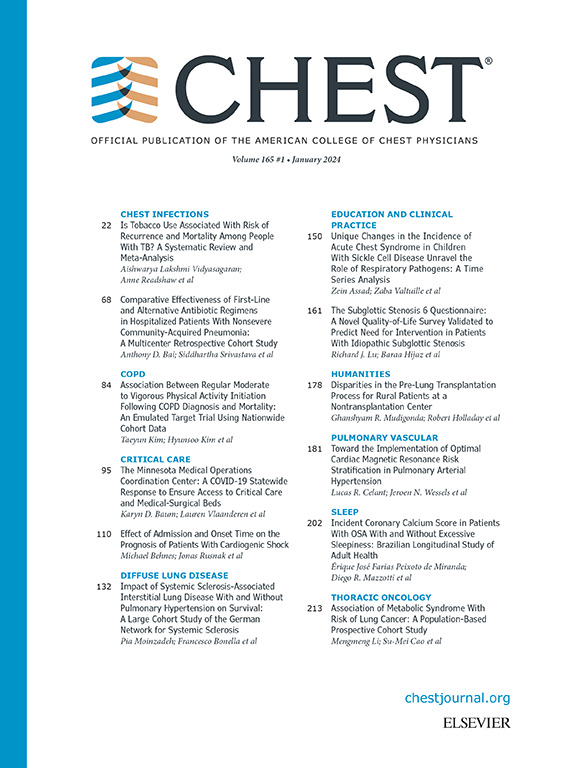Characterizing Sarcoidosis Patients with Obstructive Respiratory Physiology.
IF 9.5
1区 医学
Q1 CRITICAL CARE MEDICINE
引用次数: 0
Abstract
BACKGROUND Lung involvement occurs in over 95% of sarcoidosis cases. The World Association of Sarcoidosis and Other Granulomatous Disorders (WASOG) organ assessment tool does not assign the likelihood of lung involvement based on Pulmonary Function Testing (PFT). Clinical characteristics linked to normal and abnormal physiologic pattern on PFT's in sarcoidosis are incompletely understood. RESEARCH QUESTION What is the frequency of obstructive physiology (OP), restrictive physiology (RP) or normal physiology in sarcoidosis patients and are there laboratory parameters linked to these different patterns? STUDY DESIGN AND METHODS We evaluated 253 sarcoidosis patients by their PFT findings and grouped them into OP, RP, and normal spirometry. We correlated these PFTs to demographic, clinical, and laboratory parameters. In some cases, we correlated the PFT abnormalities with proteins in the Olink metabolic and immune response protein panels. RESULTS Of the 253 cases studied, 64% had normal spirometry, 20% had OP, and 15% had RP. Abnormal PFTs were more frequent in males with 61.2% of the OP group and 82.1% of the RP group (p=0.002). The average lymphocyte percentage was lower in OP vs. RP (normal: 21.5%, OP: 17.3%, RP: 23.7%, p =0.04), sIL-2R was lower in OP vs normal (normal:632.1, OP 335.5, RP:563.4, p =0.026) and CRP was lower in OP vs RP, and in normal vs RP (normal:11.7, OP 8.2, RP:35.6, p =0.018). Those with RP had less splenic involvement (normal: 21.5%, OP 21.6%, RP: 2.6%, P=0.008). Five Immune Response proteins had differential abundance in the three comparison groups. INTERPRETATION Most of our sarcoidosis cohort has normal spirometry. When abnormal, OP was more common than RP. There may be a difference in immune mechanisms in those with OP compared to those with RP or normal spirometry. Continued comprehensive assessments of serum proteins may identify biomarkers to identify physiologic abnormalities and guide management.结节病患者的阻塞性呼吸生理特征。
背景:95%以上的结节病病例累及肺部。世界结节病和其他肉芽肿性疾病协会(WASOG)器官评估工具没有根据肺功能测试(PFT)分配肺部受累的可能性。结节病中PFT的正常和异常生理模式的临床特征尚不完全清楚。研究问题:结节病患者出现阻塞性生理(OP)、限制性生理(RP)或正常生理的频率是多少?是否有与这些不同模式相关的实验室参数?研究设计和方法:我们根据PFT结果对253例结节病患者进行评估,并将其分为OP、RP和正常肺量测定组。我们将这些pft与人口学、临床和实验室参数联系起来。在某些情况下,我们将PFT异常与Olink代谢和免疫反应蛋白面板中的蛋白质联系起来。结果253例患者中,64%肺功能正常,20%为OP, 15%为RP。男性pft异常发生率更高,OP组为61.2%,RP组为82.1% (p=0.002)。OP组平均淋巴细胞百分比低于RP组(正常:21.5%,OP: 17.3%, RP: 23.7%, p =0.04), sIL-2R低于OP组(正常:632.1,OP 335.5, RP:563.4, p =0.026), CRP低于OP组和正常组(正常:11.7,OP 8.2, RP:35.6, p =0.018)。RP组脾受累较少(正常:21.5%,OP: 21.6%, RP: 2.6%, P=0.008)。五种免疫反应蛋白在三个对照组中有不同的丰度。大多数结节病患者肺量测定正常。异常时,OP多于RP。OP患者的免疫机制与RP患者或正常肺活量测定者相比可能存在差异。持续全面的血清蛋白评估可以识别生物标志物,以识别生理异常并指导治疗。
本文章由计算机程序翻译,如有差异,请以英文原文为准。
求助全文
约1分钟内获得全文
求助全文
来源期刊

Chest
医学-呼吸系统
CiteScore
13.70
自引率
3.10%
发文量
3369
审稿时长
15 days
期刊介绍:
At CHEST, our mission is to revolutionize patient care through the collaboration of multidisciplinary clinicians in the fields of pulmonary, critical care, and sleep medicine. We achieve this by publishing cutting-edge clinical research that addresses current challenges and brings forth future advancements. To enhance understanding in a rapidly evolving field, CHEST also features review articles, commentaries, and facilitates discussions on emerging controversies. We place great emphasis on scientific rigor, employing a rigorous peer review process, and ensuring all accepted content is published online within two weeks.
 求助内容:
求助内容: 应助结果提醒方式:
应助结果提醒方式:


